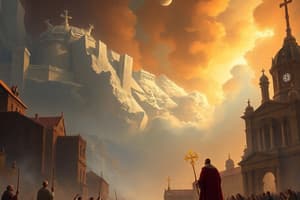Podcast
Questions and Answers
What is the Great Schism?
What is the Great Schism?
The split between Eastern Orthodox and Western Roman Catholicism.
What is iconoclasm?
What is iconoclasm?
Iconoclasm is the social belief in the importance of the destruction of icons and other images or monuments.
How was iconoclasm used in the Great Schism?
How was iconoclasm used in the Great Schism?
Byzantine Iconoclasm widened the divergence and tension between the East and the West.
What were the outcomes and consequences of the Great Schism?
What were the outcomes and consequences of the Great Schism?
Who were key players in the Great Schism?
Who were key players in the Great Schism?
Who is Pope Leo IX?
Who is Pope Leo IX?
Who is Patriarch Michael Cerularius?
Who is Patriarch Michael Cerularius?
What was the relationship between the Pope in the West and the Patriarch in the East?
What was the relationship between the Pope in the West and the Patriarch in the East?
What was the Filioque clause and why was it significant?
What was the Filioque clause and why was it significant?
When did the Great Schism occur?
When did the Great Schism occur?
Flashcards are hidden until you start studying
Study Notes
Overview of the Great Schism
- The Great Schism refers to the split between Eastern Orthodox and Western Roman Catholic churches in 1054.
- This event marked a significant division in Christianity, leading to the establishment of two distinct denominations.
Iconoclasm
- Iconoclasm involves the destruction of religious images and monuments, often influenced by political and religious beliefs.
- In the context of the Great Schism, Byzantine Iconoclasm exacerbated tensions between the Eastern and Western churches, with the West supporting the use of icons.
Consequences of the Great Schism
- The schism resulted in a permanent division between the Byzantine Church and the Roman Catholic Church.
- The weakening of confidence in Catholic leadership eventually contributed to the Reformation.
- It initiated mutual excommunications between Western popes and Eastern patriarchs.
Key Figures
- Pope Leo IX: A prominent figure in the schism, recognized as a significant German pope whose actions contributed to the division. He is venerated as a saint in the Catholic Church.
- Patriarch Michael I Cerularius: He played a crucial role by excommunicating Pope Leo IX and opposing various church practices, which fueled the schism.
East-West Relations
- The disconnection of the Western Empire led to rule by Germanic tribes, while the Eastern Empire survived for nearly a millennium, creating a long-term cultural and political divide.
- The Filioque clause added by the West to the Nicene Creed, asserting the Holy Spirit's procession from the Father and the Son, created doctrinal conflict and concerns for the East.
Linguistic and Cultural Divisions
- Communication issues arose due to language differences; Greek was predominant in the East, while Latin was used in the Western church.
- Diverging practices and beliefs, such as the Filioque addition, intensified the rift between the two branches of Christianity.
Date of the Schism
- The Great Schism was triggered on July 16, 1054, when Patriarch Michael Cerularius was excommunicated, formally establishing the separation into Roman Catholic and Eastern Orthodox churches.
Studying That Suits You
Use AI to generate personalized quizzes and flashcards to suit your learning preferences.





